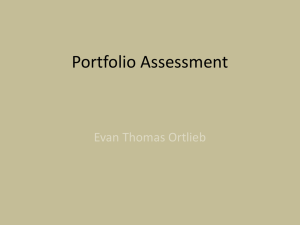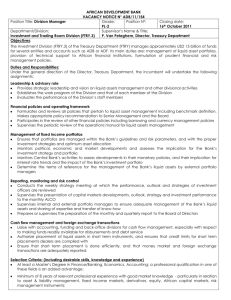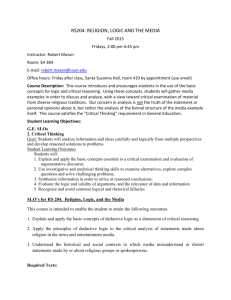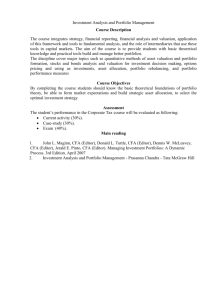A Case for Index Fund Portfolios
advertisement
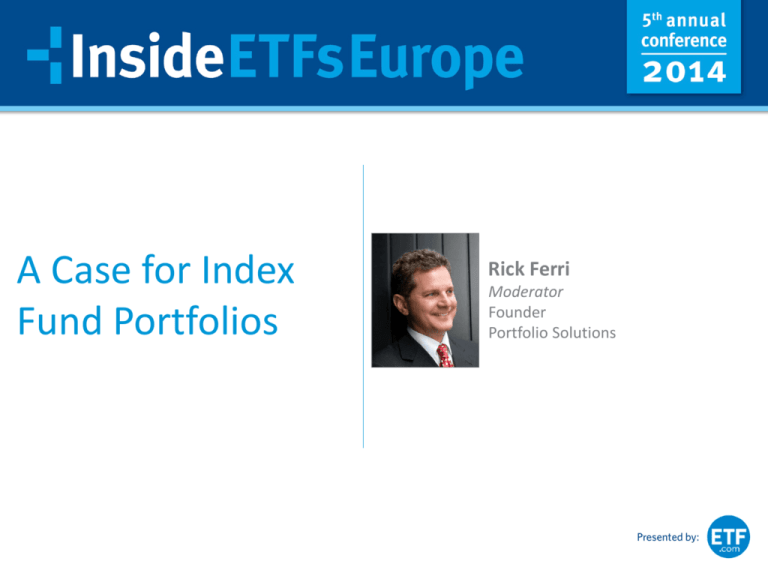
A Case for Index Fund Portfolios Rick Ferri Moderator Founder Portfolio Solutions Scope of the Research Index fund outperformance relative to active funds is widely documented. Outperformance exists across all asset classes. A portfolio of index funds naturally is expected to outperform a portfolio of actively managed funds Surprisingly little research compares the performance on portfolios using index to portfolios using active funds. Database CRSP Survivor-Bias-Free US Mutual Fund Database through December 2012. Covers all active funds and index funds that were available for purchase over the period. Provides a real-world investor experience when building mutual fund portfolios. 32 different index portfolio scenarios; 5 are show in this presentation. Scenario #1: Three Funds 40% US total stock market, 20% total int’l stocks, 40% US total bond market. Vanguard index funds (Investor shares) 40% Total Stock Market Index (VTSMX) 20% Total International Stock Index (VGTSX) 40% Total Bond Market Index (VBMFX) 5,000 portfolios from a cleaned database No B shares, C shares, annuities, institutional Did not include loads, redemption fees or taxes Results of Scenario #1 Expected Results vs. Results Individual Funds & Indexing Portfolios (1997-2012) Win Rate VTSMX (US equity: 40%) 77.1% VGTSX (Int’l equity: 20%) 62.5% VBMFX (US bonds: 40%) 91.5% Weighted 40%/20%/40% 79.9% Scenario 1 Results 82.9% 2 Out of 3 Wins Can Be A Loss Individual Fund VTSMX (US equity: 40%) VGTSX (Int’l equity: 20%) VBMFX (US bonds: 40%) Median Performance Loss -2.01% -1.75% -0.99% Median Performance Win 0.97% 1.34% 0.23% 1.34% 0.23% -0.44% -2.01% US Equity International Bond Portfolio Scenario #2: Time Effect Vanguard index funds from Scenario #1 Three independent 5-year periods 1998-2002; 2003-2007; 2008-2012 One 15-year period 40% (VTSMX); 20% (VGTSX); 40% (VBMFX) 1998-2012 5,000 active fund portfolios per trail Does time make a difference? Time is on the Side of Indexing 100% 90% 80% 70% 85.8% 83.4% 77.5% 5-yr. average 66.1% 60% 50% 5-year 1998-2002 5-year 2003-2007 5-year 2008-2012 15-year 1998-2012 Scenario #3: Multi-Asset Class 3 fund equal weight (33% each) US total stock, total int’l stock, US total bond 5 fund equal weight (20% each) 3 fund plus REITs and short-term Treasury 10 fund equal weight (10% each) Large cap US equity, mid cap US, small cap US, REITs, developed market equity, emerging market equity, US total bond, short-term Treasury bonds, inflation-protected securities, tax-exempt bonds. 10-year period: 2003-2012 5,000 active fund portfolios per trail More Index Funds Are Better Index Portfolio Win Rate Median Active Portfolio Loss Median Active Portfolio Win Three-fund portfolio 87.7% -1.47% 0.54% Five-fund portfolio 87.8% -1.10% 0.44% Ten-fund portfolio 90.0% -0.93% 0.29% Portfolio Scenario #4: Multiple Active Investors often select more than one active fund in each asset class. What effect does this have on probabilities? Three-asset-class portfolio from Scenario #1 3 trials; 16 years (1997-2012) 1 active fund per asset class selected 2 active funds per asset class selected 3 active funds per asset class selected 5,000 active fund portfolios per trial Bet The Farm On One Active Fund 91.0% 87.1% 82.9% One Active Fund Per Two Active Funds Per Asset Class Asset Class Three Active Funds Per Asset Class Scenario #5: Risk-Adjusted Do active portfolios perform better on a riskadjusted basis using Sharpe ratios? Thee-fund portfolios used in Scenario #1 Time Period 1998-2002 2003-2007 2008-2012 1997-2004 2005-2012 1997-2012 Number of Years Index Portfolio Win % Risk-Adjusted Index Win % 5 5 5 8 8 16 66.1% 85.8% 77.5% 75.7% 84.7% 82.9% 64.9% 91.0% 77.7% 74.6% 85.3% 85.5% Scenario #6: Low-Fee Fund Do active portfolios that select funds with belowaverage fees perform better? Thee-fund portfolios used in Scenario #1 Lower-cost Admiral shares for index funds Active funds selected had expense ratios below average for their categories. 16 years: 1997 to 2012 All Fund Vs. Low Fee 6 4 All active funds Low-fee active funds 2 0 -2 All active funds vs. Investor shares Index portfolios win: 82.9% Winning active median: 0.52% Losing active median: -1.25% -4 -6 Low-fee active funds vs. Admiral shares Index portfolios win: 74.7% Winning active median: 0.54% -8 0% 10% 20% 30% 40% 50% 60% 70% 80% 90% 100% Highlights Index fund portfolios had better performance nominally and risk-adjusted in all scenarios. Winning active portfolio alphas are meager relative to losing portfolios’ shortfalls. Index fund portfolio win rate increased with time, diversification, and when multiple active funds are used in asset classes. Active fund portfolios benefit from low fees, but still far below index portfolios. Where To Get The Study Download the PDF from: www.RickFerri.com www.PortfolioSolutions.com www.Betterment.com For inquires: RFerri@PortfolioSolutions.com For source code: Alex@Betterment.com Thank You. A Case for Index Fund Portfolios Rick Ferri Moderator Founder Portfolio Solutions


